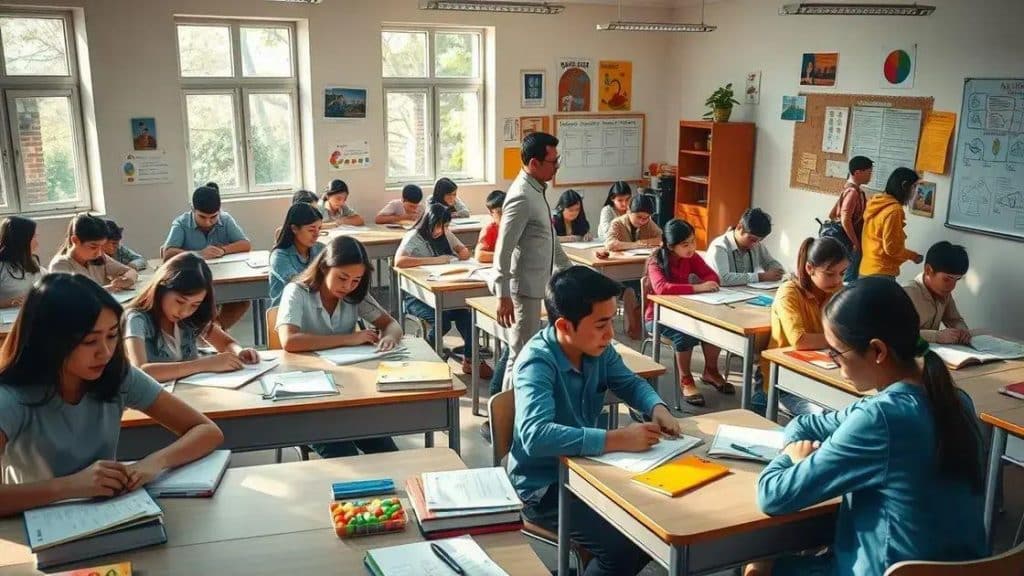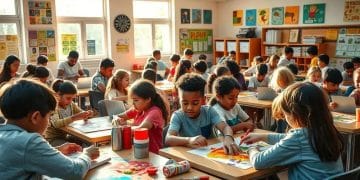Naep reading decline high school us: what’s happening?

The decline in NAEP reading skills among high school students is driven by socioeconomic factors, technological distractions, and ineffective teaching methods, highlighting the urgent need for targeted educational strategies.
NAEP reading decline high school US isn’t just a statistic; it’s a reality affecting our educational landscape. Have you noticed how reading scores have shifted over the years? Let’s dive into the crucial factors behind this issue.
Understanding the NAEP assessment and its significance
Understanding the NAEP assessment is essential for grasping the current state of education in the United States. This nationwide assessment measures students’ proficiency in various subjects, including reading. Its significance extends beyond mere scores; it provides crucial insights into educational trends and student learning.
What is the NAEP?
The National Assessment of Educational Progress (NAEP), often referred to as the “Nation’s Report Card,” is the largest ongoing assessment of what students across the country know and can do in key subject areas.
- The NAEP tests students in grades 4, 8, and 12.
- It evaluates critical skills that are essential for academic success.
- Results are reported as average scores and percentages of students reaching different achievement levels.
This assessment has been around since 1969 and focuses not only on reading but also on mathematics, science, history, and other subjects. Understanding the NAEP assessment helps educators identify gaps in knowledge and adjust their teaching strategies accordingly.
The Importance of NAEP Results
NAEP scores play a significant role in shaping educational policy. They influence how resources are allocated and which educational programs receive attention. These scores allow states and schools to compare their performance to national averages, helping to highlight areas needing improvement.
- State-level performance can be analyzed to ensure equitable education.
- NAEP results provide evidence of trends over time, indicating progress or decline.
- They highlight disparities among different demographic groups.
In an increasingly competitive world, understanding the NAEP assessment is vital for ensuring that all students receive a high-quality education. The findings serve as a benchmark for educational improvement and a guide for future strategies.
Continued analysis of NAEP results supports the ongoing effort to enhance learning for all students, making it a fundamental component of the U.S. education system.
Key statistics on NAEP reading scores

Examining the key statistics on NAEP reading scores reveals significant trends in U.S. education. These numbers help us understand where students stand in terms of their reading abilities across different states.
Current NAEP Reading Scores
The latest NAEP assessment shows a noticeable decline in reading scores for high school students. Understanding these statistics is crucial for identifying areas that require attention and improvement.
- In 2022, the average reading score for 12th graders dropped to its lowest level in a decade.
- Only 37% of high school seniors perform at or above the proficient level.
- Comparisons show significant disparities between different demographics and regions.
This data serves as a wake-up call for educators and policymakers alike. It’s vital to assess how these statistics impact curriculum design and teaching methodologies.
Demographic Insights
The NAEP reading scores also illustrate performance gaps among various demographic groups. For instance, socioeconomic status and access to resources significantly affect outcomes.
- Students from low-income households often score lower than their peers.
- There are gender disparities, with female students generally outperforming male students.
- Racial and ethnic groups show varied levels of achievement, highlighting a need for targeted support.
By delving into these statistics, educators can better understand the unique challenges faced by different groups, laying the groundwork for tailored educational strategies. Addressing these gaps is necessary for achieving educational equity.
Tracking the progress of NAEP reading scores over the years not only informs us about current performance but also guides future improvements in teaching practices and learning outcomes.
Factors contributing to the decline in reading skills
The decline in reading skills among students is a pressing issue that impacts their overall academic performance. Various factors contribute to this troubling trend, and understanding these elements is crucial.
Socioeconomic Factors
One of the key contributors to the decline in reading skills is the socioeconomic status of students. Children from low-income families may lack access to resources such as books and educational materials. This absence can lead to a significant disadvantage in developing essential reading skills.
- Limited access to quality literacy programs.
- Fewer opportunities for enrichment activities.
- Increased stressors in low-income households that distract from learning.
Addressing these challenges requires systemic changes to provide equal access to educational resources for all students.
Impact of Technology
Another factor for consideration is the influence of technology on reading habits. While technology can enhance learning, it can also detract from traditional reading. Many students spend excessive time on digital devices, which may lead to a decline in print literacy.
- Increased screen time can lead to shorter attention spans.
- Reading online may not engage students as deeply as traditional books.
- Students may struggle with comprehension when reading digital texts.
Finding a balance between technology and traditional reading is crucial for improving literacy rates.
Teaching Methods
Additionally, some teaching methods may contribute to the decline in reading skills. Traditional approaches may not engage all learners effectively. Implementing diverse strategies that cater to different learning styles is essential.
- Incorporating interactive reading activities.
- Using culturally relevant materials to engage students.
- Providing personalized instruction to meet individual needs.
Equipped teachers can make a significant difference in fostering a love of reading among students. Enhancing the curriculum is a necessary step to combat the decline.
Ultimately, addressing these contributing factors requires collaboration between educators, policymakers, and communities to ensure that every student has the opportunity to develop their reading skills.
Potential solutions and instructional strategies

To address the decline in reading skills, implementing effective solutions and instructional strategies is essential. By focusing on tailored methods, educators can help students improve their literacy and overall academic performance.
Engaging Reading Programs
One potential solution is to develop engaging reading programs that captivate students’ interests. Programs should include a variety of genres and topics to appeal to diverse learners. This can motivate students to read more and improve their comprehension skills.
- Incorporate popular literature and graphic novels.
- Use thematic units that connect reading material to real-life experiences.
- Encourage book clubs where students can discuss their readings.
By making reading enjoyable, students are more likely to develop a lifelong love for literature.
Diverse Instructional Approaches
Another key strategy involves using diverse instructional approaches to address different learning styles. Recognizing that not all students learn the same way allows educators to tailor their methods accordingly. This may include:
- Integrating technology, such as reading apps and online resources.
- Utilizing visual aids to support comprehension.
- Implementing hands-on activities that enhance the learning experience.
Adapting teaching methods ensures that all students can engage with the material effectively. When students receive instruction that resonates with their individual needs, they are more inclined to succeed.
Professional Development for Educators
Investing in professional development for educators is another critical aspect. Training teachers in new literacy strategies can empower them to make a difference in student outcomes. Workshops and ongoing training can cover:
- Current research on literacy and reading instruction.
- Best practices for fostering a reading culture in the classroom.
- Strategies to integrate reading across the curriculum.
Educators equipped with the latest knowledge can implement effective teaching strategies that benefit their students. A supportive learning environment facilitates student growth.
By employing these potential solutions and instructional strategies, schools can create an atmosphere where effective reading skills are cultivated and celebrated. Addressing the decline in reading requires collaborative efforts from both teachers and students.
To summarize, the decline in reading skills among high school students is a significant issue that requires immediate attention. Understanding the factors contributing to this decline is crucial for developing effective solutions. By focusing on engaging reading programs, utilizing diverse instructional strategies, and investing in professional development, educators can create an environment that fosters improved literacy. Collaborating to implement these strategies can help students build essential reading skills, ensuring they are prepared for future academic challenges and opportunities. Together, we can turn the tide on reading decline and support every student’s journey in becoming a confident and capable reader.
FAQ – Frequently Asked Questions about NAEP Reading Skills
What is the NAEP assessment?
The NAEP assessment, known as the Nation’s Report Card, measures students’ proficiency in subjects like reading across the U.S.
Why are reading skills important for students?
Reading skills are crucial for academic success, allowing students to understand and engage with their studies effectively.
What factors contribute to the decline in reading skills?
Key factors include socioeconomic status, the impact of technology, and traditional teaching methods that may not engage all learners.
What are effective strategies to improve reading skills?
Effective strategies include creating engaging reading programs, utilizing diverse instructional approaches, and providing professional development for educators.





